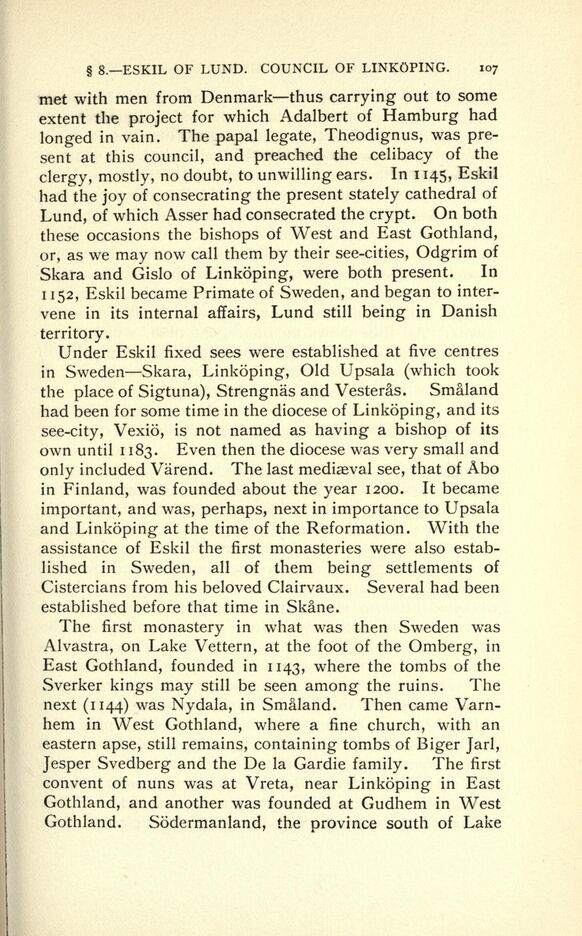
Full resolution (JPEG) - On this page / på denna sida - III. The Romanized Church under the Sverkers, Erics and Folkungar (1130—1389 A.D.)

<< prev. page << föreg. sida << >> nästa sida >> next page >>
Below is the raw OCR text
from the above scanned image.
Do you see an error? Proofread the page now!
Här nedan syns maskintolkade texten från faksimilbilden ovan.
Ser du något fel? Korrekturläs sidan nu!
This page has never been proofread. / Denna sida har aldrig korrekturlästs.
8. ESKIL OF LUND. COUNCIL OF LINKOPING. 107
met with men from Denmark thus carrying out to some
extent the project for which Adalbert of Hamburg had
longed in vain. The papal legate, Theodignus, was pre
sent at this council, and preached the celibacy of the
clergy, mostly, no doubt, to unwilling ears. In 1 145, Eskil
had the joy of consecrating the present stately cathedral of
Lund, of which Asser had consecrated the crypt. On both
these occasions the bishops of West and East Gothland,
or, as we may now call them by their see-cities, Odgrim of
Skara and Gislo of Linkoping, were both present. In
1
152, Eskil became Primate of Sweden, and began to inter
vene in its internal affairs, Lund still being in Danish
territory.
Under Eskil fixed sees were established at five centres
in Sweden Skara, Linkoping, Old Upsala (which took
the place of Sigtuna), Strengnas and Vesteras. Smaland
had been for some time in the diocese of Linkoping, and its
see-city, Vexio, is not named as having a bishop of its
own until 1183. Even then the diocese was very small and
only included Varend. The last mediaeval see, that of Abo
in Finland, was founded about the year 1200. It became
important, and was, perhaps, next in importance to Upsala
and Linkoping at the time of the Reformation. With the
assistance of Eskil the first monasteries were also estab
lished in Sweden, all of them being settlements of
Cistercians from his beloved Clairvaux. Several had been
established before that time in Skane.
The first monastery in what was then Sweden was
Alvastra, on Lake Vettern, at the foot of the Omberg, in
East Gothland, founded in 1143, where the tombs of the
Sverker kings may still be seen among the ruins. The
next (1144) was Nydala, in Smaland. Then came Varn-
hem in West Gothland, where a fine church, with an
eastern apse, still remains, containing tombs of Biger Jarl,
Jesper Svedberg and the De la Gardie family. The first
convent of nuns was at Vreta, near Linkoping in East
Gothland, and another was founded at Gudhem in West
Gothland. Sodermanland, the province south of Lake
<< prev. page << föreg. sida << >> nästa sida >> next page >>